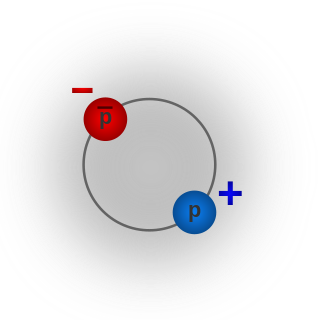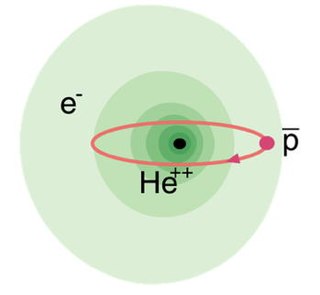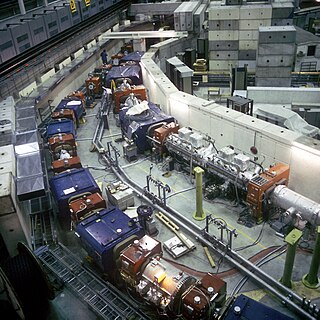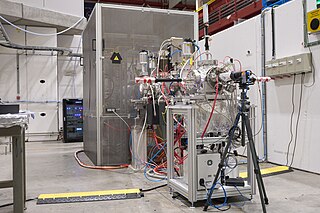
In modern physics, antimatter is defined as matter composed of the antiparticles of the corresponding particles in "ordinary" matter, and can be thought of as matter with reversed charge, parity, and time, known as CPT reversal. Antimatter occurs in natural processes like cosmic ray collisions and some types of radioactive decay, but only a tiny fraction of these have successfully been bound together in experiments to form antiatoms. Minuscule numbers of antiparticles can be generated at particle accelerators; however, total artificial production has been only a few nanograms. No macroscopic amount of antimatter has ever been assembled due to the extreme cost and difficulty of production and handling. Nonetheless, antimatter is an essential component of widely available applications related to beta decay, such as positron emission tomography, radiation therapy, and industrial imaging.

The positron or antielectron is the particle with an electric charge of +1e, a spin of 1/2, and the same mass as an electron. It is the antiparticle of the electron. When a positron collides with an electron, annihilation occurs. If this collision occurs at low energies, it results in the production of two or more photons.

Antihydrogen is the antimatter counterpart of hydrogen. Whereas the common hydrogen atom is composed of an electron and proton, the antihydrogen atom is made up of a positron and antiproton. Scientists hope that studying antihydrogen may shed light on the question of why there is more matter than antimatter in the observable universe, known as the baryon asymmetry problem. Antihydrogen is produced artificially in particle accelerators.

The antiproton,
p
, is the antiparticle of the proton. Antiprotons are stable, but they are typically short-lived, since any collision with a proton will cause both particles to be annihilated in a burst of energy.
ATHENA, also known as the AD-1 experiment, was an antimatter research project at the Antiproton Decelerator at CERN, Geneva. In August 2002, it was the first experiment to produce 50,000 low-energy antihydrogen atoms, as reported in Nature. In 2005, ATHENA was disbanded and many of the former members of the research team worked on the subsequent ALPHA experiment and AEgIS experiment.

Protonium, also known as antiprotonic hydrogen, is a type of exotic atom in which a proton and an antiproton are bound to each other.
The Antihydrogen Trap (ATRAP) collaboration at the Antiproton Decelerator facility at CERN, Geneva, is responsible for the AD-2 experiment. It is a continuation of the TRAP collaboration, which started taking data for the TRAP experiment in 1985. The TRAP experiment pioneered cold antiprotons, cold positrons, and first made the ingredients of cold antihydrogen to interact. Later ATRAP members pioneered accurate hydrogen spectroscopy and observed the first hot antihydrogen atoms.

Antiprotonic helium is a three-body atom composed of an antiproton and an electron orbiting around a helium nucleus. It is thus made partly of matter, and partly of antimatter. The atom is electrically neutral, since both electrons and antiprotons each have a charge of −1, whereas helium nuclei have a charge of +2. It has the longest lifetime of any experimentally producible matter-antimatter bound state.

The gravitational interaction of antimatter with matter or antimatter has been observed by physicists. As was the consensus among physicists previously, it was experimentally confirmed that gravity attracts both matter and antimatter at the same rate within experimental error.

The Antiproton Decelerator (AD) is a storage ring at the CERN laboratory near Geneva. It was built from the Antiproton Collector (AC) to be a successor to the Low Energy Antiproton Ring (LEAR) and started operation in the year 2000. Antiprotons are created by impinging a proton beam from the Proton Synchrotron on a metal target. The AD decelerates the resultant antiprotons to an energy of 5.3 MeV, which are then ejected to one of several connected experiments.

The Low Energy Anti-Proton Ring (LEAR) was a particle accelerator at CERN which operated from 1982 until 1996. The ring was designed to decelerate and store antiprotons, to study the properties of antimatter and to create atoms of antihydrogen. Antiprotons for the ring were created by the CERN Proton Synchrotron via the Antiproton Collector and the Antiproton Accumulator (AA). The creation of at least nine atoms of antihydrogen were confirmed by the PS210 experiment in 1995.
Atomic Spectroscopy and Collisions Using Slow Antiprotons (ASACUSA), AD-3, is an experiment at the Antiproton Decelerator (AD) at CERN. The experiment was proposed in 1997, started collecting data in 2002 by using the antiprotons beams from the AD, and will continue in future under the AD and ELENA decelerator facility.
High-precision experiments could reveal small previously unseen differences between the behavior of matter and antimatter. This prospect is appealing to physicists because it may show that nature is not Lorentz symmetric.

The Antiproton Collector (AC) was part of the antiparticle factory at CERN designed to decelerate and store antimatter, to study the properties of antimatter and to create atoms of antihydrogen. It was built in 1986 around the existing Antiproton Accumulator (AA) to improve the antiproton production by a factor of 10. Together, the Antiproton Collector and the Antiproton Accumulator formed the so-called Antiproton Accumulator Complex (AAC).

The Antihydrogen Laser Physics Apparatus (ALPHA), also known as AD-5, is an experiment at CERN's Antiproton Decelerator, designed to trap antihydrogen in a magnetic trap in order to study its atomic spectra. The ultimate goal of the experiment is to test CPT symmetry through comparing the respective spectra of hydrogen and antihydrogen. Scientists taking part in ALPHA include former members of the ATHENA experiment (AD-1), the first to produce cold antihydrogen in 2002.

GBAR, AD-7 experiment, is a multinational collaboration at the Antiproton Decelerator of CERN.
The rotating wall technique is a method used to compress a single-component plasma confined in an electromagnetic trap. It is one of many scientific and technological applications that rely on storing charged particles in vacuum. This technique has found extensive use in improving the quality of these traps and in tailoring of both positron and antiproton plasmas for a variety of end uses.

Jeffrey Scott Hangst is an experimental particle physicist at Aarhus University, Denmark, and founder and spokesperson of the ALPHA collaboration at the Antiproton Decelerator (AD) at CERN, Geneva. He was also one of the founding members and the Physics Coordinator of the ATHENA collaboration at the AD facility.

Stefan Ulmer is a particle physicist, professor of Physics at Heinrich Heine University Düsseldorf and chief scientist at the Ulmer Fundamental Symmetries Laboratory, RIKEN, Tokyo. He is the founder and the spokesperson of the BASE experiment (AD-8) at the Antiproton Decelerator facility at CERN, Geneva. Stefan Ulmer is well known for his contributions to improving Penning trap techniques and precision measurements on antimatter. He is the first person to observe spin transitions with a single trapped proton as well as single spin transitions with a single trapped antiproton, a significant achievement towards a precision measurement of the antiproton magnetic moment.

The PUMA AD-9 experiment, at the Antiproton decelerator (AD) facility at CERN, Geneva, aims to look into the quantum interactions and annihilation processes between the antiprotons and the exotic slow-moving nuclei. PUMA's experimental goals require about one billion trapped antiprotons made by AD and ELENA to be transported to the ISOLDE-nuclear physics facility at CERN, which will supply the exotic nuclei. Antimatter has never been transported out of the AD facility before. Designing and building a trap for this transportation is the most challenging aspect for the PUMA collaboration.

















